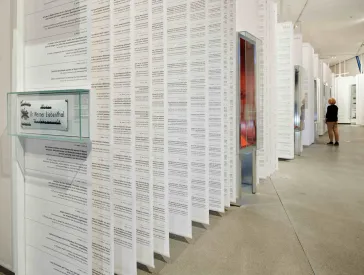With Love from Fromet and Moses Mendelssohnplatz!
The Mendelssohns’ Marriage Inscribed in the Map of Berlin
Since 2013, the new plaza on Lindenstrasse between the Jewish Museum Berlin and our Academy has borne an official name: Fromet-und-Moses-Mendelssohn-Platz. After a protracted decision-making process, both Fromet Mendelssohn, née Gugenheim, and her husband Moses have been immortalized on the map of Berlin. Ample reason to learn more about the exceptional couple!
Street sign on the town square in front of the W. Michael Blumenthal Academy; Jewish Museum Berlin, photo: Roman März
In the spring of 1761, when philosopher Moses Mendelssohn met the merchant’s daughter Fromet Gugenheim during a visit to Hamburg, his fate was sealed: he declared his love for her in a garden pavilion, and “stole a few kisses from her lips.” He returned, besotted, to Berlin and wrote to his friend Gotthold Ephraim Lessing:
“I have committed the folly of falling in love in my thirtieth year. The woman I wish to marry has no assets, is neither beautiful nor erudite; yet I am a lovesick beau, so smitten that I believe I could live with her happily ever after.”
The two were wed in June 1762. That they married for love was highly unusual: most marriages at the time were arranged by matchmakers. “[O]ur correspondence can do without ceremony,” Moses assured Fromet on 15 May 1761, in the very first of his letters to his bride: “…our hearts will respond.”
“Before I met you, my love, solitude was my Garden of Eden. But it is intolerable to me now.” Berlin, 24 October 1761
Who is Fromet Gugenheim/Mendelssohn?
Fromet Mendelssohn, née Gugenheim (1737–1812), businesswoman and homemaker from Altona, daughter of a merchant, love marriage with Moses Mendelssohn in 1762; their letters document their relationship as intellectual equals
Who is Moses Mendelssohn?
Moses Mendelssohn (1729–1786), a leading philosopher of the Enlightenment who championed legal equality for Jews in Germany
For over a year, Moses Mendelssohn and Fromet Gugenheim sent each other two letters a week. Several of Moses Mendelssohn’s so-called “letters to his bride” and Fromet Mendelssohn’s “letters from a marriage” have survived, and are now held by the Music Department of the Staatsbibliothek in Berlin. They were written in Judeo-German, in Hebrew characters, which was common at the time. The letters touch upon themes such as Moses Mendelssohn’s criticism of traditional Jewish marriage contracts, and the legislation pertaining to Jews’ right to settle in Berlin – as a native of Dessau, Mendelssohn had to apply for a permit to marry his Hamburg-born bride in Berlin – as well as their future home in Berlin, the intellectual debates pursued by the lovestruck couple and their friends, and – in a delightful letter dated 2 October 1761 – the defense of the wig.
“You have a too noble mind to even begin to imagine what wealthy Berliners are like. If ever I am lucky enough to see you here before me and, God willing, to live with you, you will have to avoid associating with our wealthy neighbors, because your character will never tolerate their way of thinking.” Berlin, 7 July 1761
Torah Curtain; Jewish Museum Berlin, accession KGT 97/1/0, purchased with funds provided by Stiftung Deutsche Klassenlotterie Berlin, photo: Roman März. More about the curtain on our website ...
Fromet and Moses Mendelssohn’s home in Berlin was known for its openness and lively intellectual exchange. The Berlin salons hosted in later years by Henriette Herz among others (a friend of Fromet’s daughter Brendel, later Dorothea Schlegel) were inspired on Fromet Mendelssohn’s company, as Mendelssohn expert Thomas Lackmann suggests.
Fromet gave birth to ten children, four of whom died in infancy. Following her husband’s death in 1786, she left Berlin with her three youngest children and settled in Strelitz. In 1800 she moved to her native city, Hamburg, where she died in 1812. Incidentally, four of Moses and Fromet’s children were baptized several years after their father’s death.
If you ever cross the plaza outside the Academy, let its name remind you of both philosophy and love, and of two extraordinary people who loved each other.
Moses Mendelssohn, Phaedon: Or, On the Immortality of the Soul, in three conversations, Berlin/Stettin: Friedrich Nicolai 1776; Jewish Museum Berlin, accession VII.5. Mende 275
Citation recommendation:
Monika Flores Martínez, Signe Rossbach (2013), With Love from Fromet and Moses Mendelssohnplatz!. The Mendelssohns’ Marriage Inscribed in the Map of Berlin.
URL: www.jmberlin.de/en/node/8805


